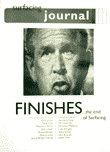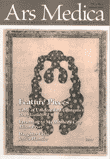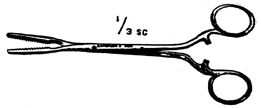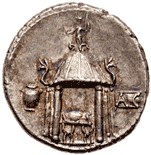 My essay, Con-Textilizing Critical Language, appears in the winter 2006 issue of Surfacing Journal, a publication of the Textile Artists & Designers Association.
My essay, Con-Textilizing Critical Language, appears in the winter 2006 issue of Surfacing Journal, a publication of the Textile Artists & Designers Association.
In this essay I suggest that less time be spent worrying about what does or does not pass for criticism, and much more time be spent on thinking about what to say, where and how to say it, and to whom. I contend that the critical decisions made by fibre artists in their work that more than qualifies them as critical voices:
High art, low art, craft or trade – the artist’s ontological position is established through the active generation of “material” language. The choices made – between riotously sexy velvet, florid fuchsia fun fur or deliberately domestic damask – speak volumes. If the vernacular is not official, or correct, or refined, or even immediately recognizably critical – so much the better, I say. Content is more critical than criticism. If the story is a good one, it will get read. So let’s focus on deciding what story to tell and how best to tell it – in fluid script discharged from printed fabric, in re-programmable circuits woven into cloth, in loaded statements laboriously crocheted from continuous thread – and forget for a while about what is or is not said about the story after the fact. Fibre Art, adept as it already is at working in the margins, has its very elusiveness at its disposal in its quest for critical language… the language of Fibre Arts can choose to include the fragmentary, the inconclusive and the digressive. It can be interlaced with texts. It can be something you can’t quite put your finger on, like the tip of a needle. It can also be as cerebral as the head of a needle. Head and point and eye, looking for just the right place to push the point… out, and out loud.
J. R. Carpenter, Con-Textilizing Critical Language, Surfacing Journal, Toronto, WInter 2006.
. . . . .
 I began writing Notions of the Archival in Memory and Deportment as a response to the discourse of disembodiment that was prevalent in early days of the Internet. I never believed that the physical gendered body would be subsumed in an idealized information age. Even in our attempts to externalize and expand upon the processes of the brain through the computational and storage capacities of the computer, the precariousness of the biological body persists. It seems to me that somewhere along the way cultural theory veered away from body politics. In Notions of the Archival in Memory and Deportment I have tried to examine, from the inside, not just ‘the’ body, but also ‘my’ body in particular. I have focused on the storage and retention of bodily memory in order to explore the relationship and/or disconnect between body and mind that has preoccupied philosophers for generations. In Ethics, Part II: Of the Nature and Origin of the Mind, Spinoza writes: “The human mind is capable of perceiving a great number of things, and … is cable of receiving a great number of impressions… If the human body is affected in a manner which involves the nature of any external body, the human mind will regard the said external body as actually existing… Memory is simply a certain association of ideas involving the nature of things outside the human body, which association arises in the mind according to the order and association of the modifications of the human body… The human mind has no knowledge of the body, and does not know it to exist, save through the ideas of the modifications whereby the body is affected.”
I began writing Notions of the Archival in Memory and Deportment as a response to the discourse of disembodiment that was prevalent in early days of the Internet. I never believed that the physical gendered body would be subsumed in an idealized information age. Even in our attempts to externalize and expand upon the processes of the brain through the computational and storage capacities of the computer, the precariousness of the biological body persists. It seems to me that somewhere along the way cultural theory veered away from body politics. In Notions of the Archival in Memory and Deportment I have tried to examine, from the inside, not just ‘the’ body, but also ‘my’ body in particular. I have focused on the storage and retention of bodily memory in order to explore the relationship and/or disconnect between body and mind that has preoccupied philosophers for generations. In Ethics, Part II: Of the Nature and Origin of the Mind, Spinoza writes: “The human mind is capable of perceiving a great number of things, and … is cable of receiving a great number of impressions… If the human body is affected in a manner which involves the nature of any external body, the human mind will regard the said external body as actually existing… Memory is simply a certain association of ideas involving the nature of things outside the human body, which association arises in the mind according to the order and association of the modifications of the human body… The human mind has no knowledge of the body, and does not know it to exist, save through the ideas of the modifications whereby the body is affected.”

